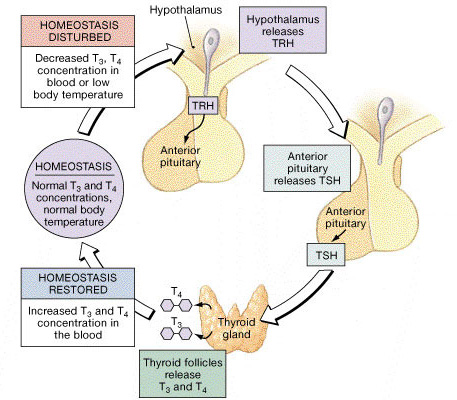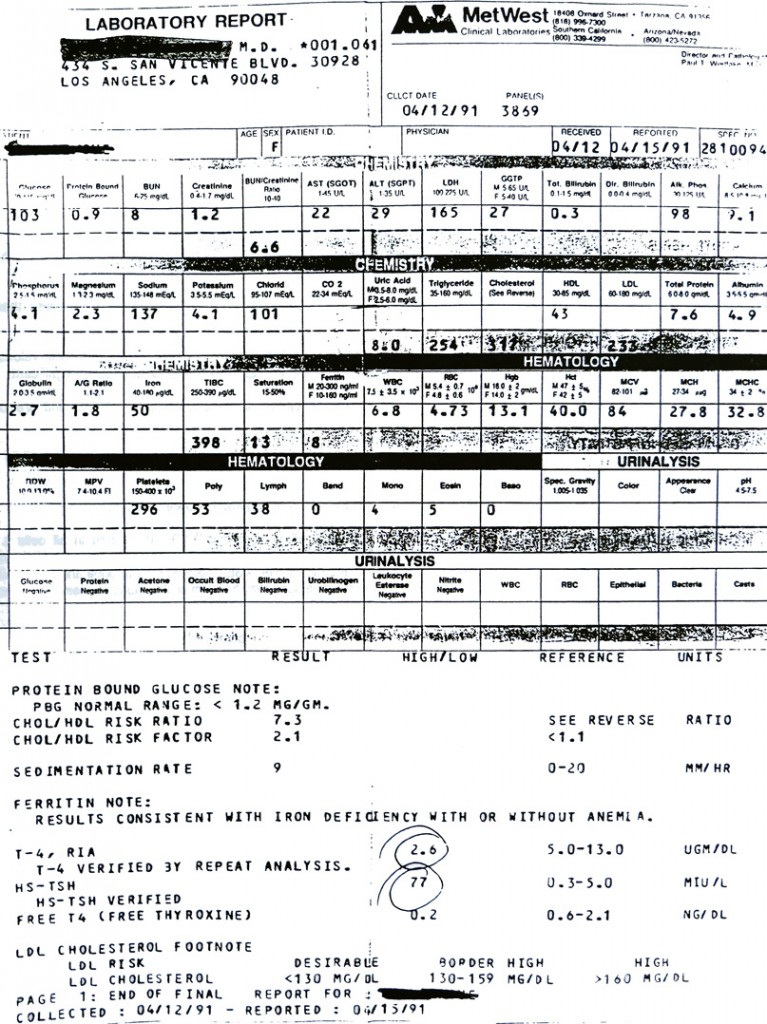The hypothalamus releases the following Releasing Hormones that stimulate the release of different hormones from the adenohypophysis:
- Corticotropin Releasing Hormone (C.R.H. causes the release of ACTH)
- Thyrotropin Releasing Hormone (T.R.H. causes the release of Thyroid Stimulating Hormone aka Thyrotropin)
- Gonadotropin Releasing Hormone (GnRH releases LH and FSH.)
- Growth Hormone R.H. & Growth Hormone I.H.
- Prolactin R.H. & Prolactin I.H.
In this post, we’re concerned with #2.
Thyrotropin literally means to affect the thyroid. Thyro-tropin. Thyro refers to Thyroid. Tropin means it’s something that affects another endocrine gland. So Thyrotropin is a hormone that affects the thyroid.
Thyrotropin stimulates your thyroid gland to secrete tetraiodothyronine (aka Thyroxin, and it’s tetra- because it has 4 iodine atoms) and a smaller amount of triodothyronine (tri- because it has 3 iodines). These are commonly referred to as T4 and T3. Thyrotropin mostly causes the thyroid gland to secrete T4 and smaller amounts of T3. T3 is more potent but we release less of it.
In other words, the factors that cause the release of T4 and T3 are Thyrotropin (aka TSH; Thyroid Stimulating Hormone) from the (anterior lobe of the) pituitary gland (the adenohypophysis).
The model of ALL tropic hormones is a NEGATIVE FEEDBACK LOOP.

See where it says hypothalamus, the hypothalamic neurons are releasing Thyrotropin Releasing Hormone (TRH). The TRH is carried down to the adenohypophysis by the hypothalamic portal veins where it releases TSH (Thyrotropin aka Thyroid Stimulating Hormone) and released into the blood stream where it stimulates the thyroid gland to release Thyroxin (T4) and T3 and as it increases in the blood stream, we go back to homeostasis.
TRH is what is stimulating the release of Thyrotropin, but something not included in that picture above is that cold temperatures and hypoglycemia also stimulate the release of thyrotropin, which in turn stimulates the thyroid to release T4/T3. We went over this when we talked about the regulation of body temperature. We said that places like Minnesota, where it’s fucking-freezing, are called meat and potatoes country, because the cold is raising their metabolism to produce more heat and making them hungrier. Contrast that with summer, when people rather eat lighter foods like salads and don’t have as much of an appetite when it’s scorching hot.
How is this controlled or regulated?
By a negative feedback loop. Most of us don’t have hypo/hyperthyroidism, because it’s under a homeostatic reflex. As the thyrotropin stimulates the thyroid to release more thyroxin, the levels of thyroxin go up in the bloodstream and that is going to inhibit further release of TSH from the the cells of the adenohypophysis and the TRH from the hypothalamic neurons. This makes sure the thyroid gland doesn’t oversecrete thyroxin
Remember how all NT are enzymatically broken down because if we don’t then the effects can go on for the rest of your life? Where most hormones are broken down is your liver. The reason your liver needs to break it down is because… consider the following: Remember how Oxytocin causes a woman to go into labor? If oxytocin isn’t broken down, she’s going to stay in labor for the rest of your life. That doesn’t sound like a good idea. So what if she gets pregnant again? The body will make more oxytocin and so on.
As the thyroxin is broken down by your liver, that takes away the inhibition because it was the elevated thyroxin levels that were inhibiting the TRH and Thyrotropin (TSH) production. This is a classic negative feedback loop. It’s imperative you understand this negative feedback loop if you understand ANYTHING from physiology. It has a short negative feedback loop and “long” negative feedback loop.
Negative Feedback Loop: What would decrease the amount of thyroxin secreted by ones body? A decreased amount of thyrotropin.
So the source of Thyroxin (T4) and T3 is the thyroid gland and interestingly they increase both your anabolic and catabolic metabolic rates. The catabolic process being the speeding up of cellular respiration and incidentally a byproduct of cellular respiration is heat (60% of the energy is given off as heat). Thyroxin is also needed for growth and development as well (that’s an anabolic process).
A deficiency of thyroxin (T4) in an adult is hypothyroidism. It’s one of the most common types of clinical problems. Since thyroxin is tied into metabolism, people with hypothyroidism are tired all the time, they are cold all the time, they can gain weight easily because instead of breaking down the food they eat, they store it on their body. There’s also a slow H.R. and low B.P. Everything is slower than usual.
 A deficiency of thyroxin(T4) in children is called cretinism and it’s VERY serious because it doesn’t only affect cellular respiration but also growth and development so they would be physically short and also mentally retarded. That’s called a cretin.
A deficiency of thyroxin(T4) in children is called cretinism and it’s VERY serious because it doesn’t only affect cellular respiration but also growth and development so they would be physically short and also mentally retarded. That’s called a cretin.
Something you may or may not know in most states today (California was the leader for this): When a baby is born, blood tests are MANDATORILY REQUIRED BY STATE LAW and the blood is usually drawn from the bottom of the foot. They are need to be tested for hypothyroidism. If the baby has hypothyroidism, Synthroid must be taken otherwise they would develop into a cretin (mental retardation and physically short). A number of tests are required by law and all of the tests are basically problems that would result in mental retardation and are all preventable. Two other tests are for PKU and Galactosemia as both will result in mental retardation but both are PREVENTABLE by putting that infant on a special artificial diet (no phenylalanine or galactose in it). It would be tragic for a baby to become mentally retarded if it was totally preventable. They don’t require a test for cystic fibrosis for example, because there’s nothing you could do about that disease.
Clinical Detail for Hypothyroidism
If you have hypothyroidism, and the problem is in your thyroid gland, it’s called primary hypothyroidism. If the problem is from the pituitary gland not releasing enough TSH, that’s called secondary hypothyroidism, but it could also be that the hypothalamus isn’t releasing enough TRH and that’s called tertiary hypothyroidism. Whether the person has a problem in the thyroid, pituitary, or hypothalamus of the brain, the treatment is the same, they need Synthroid (Levothyroxine), but it’s absolutely necessary the doctor ascertains the real cause (the due diligence for the etiology; cause) of the hypothyroidism. If the problem is in the brain, it could be a sign of something much more serious than just hypothyroidism.
Lab Form

You’re looking at the most common blood test. We’ll understand 70% of what’s written there by the time we are done with this series.
See where it says T4 RIA, the thyroxin T4 RIA level. Circled is 2.6 while the normal range is 5.0-13.0 micrograms/dL, so how would you describe this patient? That’s hypothyroidism because it’s below the normal range. The TSH levels are 77 while the normal range are 0.3-5.0 and the units are in milli international units per liter.
Based on your understanding of the negative impact loop, which type of hypothyroidism do they have? Primary or secondary hypothyroidism? They have primary hypothyroidism and this pattern is the MOST common. It’s rarer to have a problem with the pituitary. The TSH is super high because the pituitary gland is trying to get the damned thyroid gland to release some damn thyroxin by secreting more and more TSH and it’s still not working. So the pituitary is doing exactly what you would want it to do and it’s not inhibited.
Radioimmunoassay
—LOOK AT LAB FORM (page 224a after)—
Look at this lab form. See how they measure the T3 and T4 level. It’s given as a percent. The normal range is 35-45% and it’s ever so slightly outside the range, not enough to do anything. T4 is 6.9 and that is entirely within the normal range of 5.5-11.5ug/dl. This patient might have said I’m low on energy, cold all the time, etc. So they ran the tests to see if they have hypothyroidism and they ran the tests and turns out there’s no reason to be put on Synthroid (a brand name of synthetic thyroid medication).
Notice the T4 RIA is measured in micrograms/dl which is extremely tiny compared to cholesterol (something around 200mg/dL or sugar level (around 100mg/dL). A microgram is a millionth of a gram. Most hormones are measured in micrograms (10-6) or nanograms (10-9).
They had to develop a way to measure molecules on such a tiny concentration level. In the 1970’s, A woman named Rosalyn Yalow, professor of Columbia, developed the technique used today called RIA and it stands for Radioimmunoassay. When you see the word “Immuno,” you think of immunology. If you’ve had microbiology, you learned an antibody is VERY specific, and what literally binds to a hormone is an antibody. But you still have to be able to measure that binding of that antibody. So they use a radioactive antibody. Some new techniques don’t necessarily have to use a radioactive antibody, but they all use antibodies. These were commonly administered in the area of the hospital called nuclear medicine. They use these things to measure hormone levels and also cancer cells to see how far they have metastasized (spread).
Next let’s learn about ACTH.







